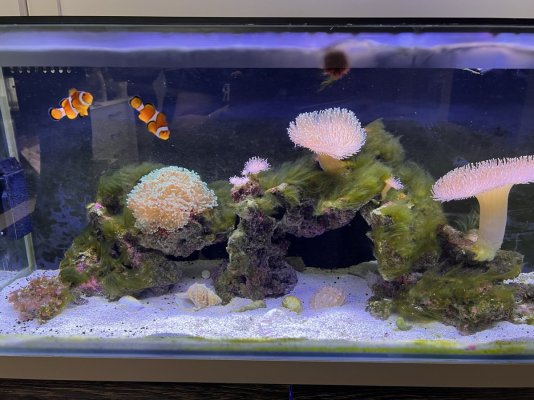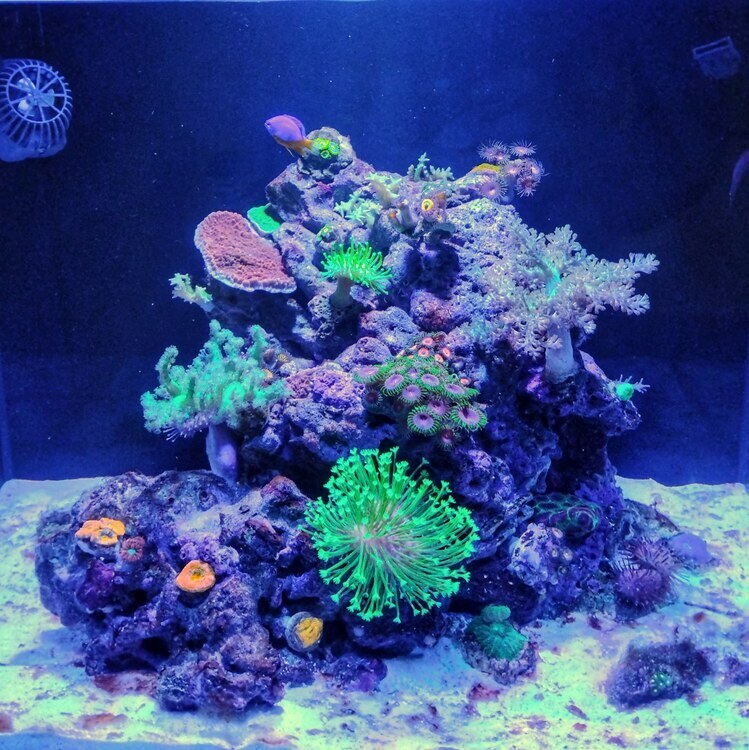Hi All,
I'm fairly new to the hobby, my tank is just over 1 year old now, for the last 3 months or so I have been battling a Horrendus hair algae outbreak, I think I have found one or many of the causes however id like to ask some questions and get a game plan for going forward? Ive read allot of forum posts about Tank Cleans H202 Treatments, using Vibrant and picking it out.
So far I have hand-picked it out and dosed some vibrant to try and get ontop of the outbreak as its been getting rather messy.
So the 2 reasons I suspect for my issue is 1 overfeeding, I have x2 clowns in a 130L tank and I feed them half a cube of frozen food each day, I use to feed a pinch of pellets but they seem happier with frozen food and tend to eat it all however it seems like way to much for them, but its a hassle to cut the cubes down to smaller portions so I stick with half a cube. i think the water in these cubes is full of nutrients and its going straight into the water and giving me a spike? Im not sure how to fix this issue as the food like brine is so tiny you cant really strain it? so is it worth going back to pellets full-time for them? to try and resolve this?
Secondly, I found out my LFS TDS reading on the last batch of water I got is 8 TDS is this good bad or normal? I know we aim for 0TDS but is there a desired range to be in? I think I remember them telling me it can be up to 14TDS but never anymore. Should I be worried about this? Or is this a acceptable range?
I just want to get rid of this issue really, my tank looks awful and each time I spend an hour picking some of the tufts it's back within a week, I now believe this is my own fault for my feeding habits and perhaps partly my LFS stores fault for higher than expected TDS?
There's no direct sunlight, and I have taken my lights from 100% (Blue, Purple, Cyan) Down to around 80%.
Im not really sure if my params are useful as there is so much algae that the phos and nitrate will likely be actively consumed by the algae to grow, but my recent tests shown:
Phos 0.10
Nitrate 20
Ammonia 0
Nitrite 0
Salinity: 1.025
KH 6.0
PH 7.8
Im considering getting a RO unit and doing a 50% water change for the next 2-3 weeks with a better quality ref salt to get the tanks water params in a better position with a higher PH and ALK, and hopefully kill off this alga with some Vibrant dosing. I know its controversial but the corals don't seem to unhappy with it and if it can kill off a good amount and some 50% water changes can export the nutrients I think I might get through this.
I also added a Tuxedo Urchin last week, and have 4 Nass Snails, 4 Trocus Snails & 3 Redf hermits in QT ready to go in at the end of Feb.
Is there anything else I can do?

Cut your photo period.
Cut down the amount of white light.
Keep peak intensity to about 4-6 hours.
Add hermit crabs and various snails.
Manually remove as much of the hair algae when you do water changes.
You should notice a reduction of the algae in a week or two.
I battled hair algae a few weeks ago. Cutting the photoperiod to 11 hours, reducing the white light to 40% (Kessils), and restocking the CUC helped tremendously.


















